technical data AUDI S8 2008 Owner's Manual
[x] Cancel search | Manufacturer: AUDI, Model Year: 2008, Model line: S8, Model: AUDI S8 2008Pages: 404, PDF Size: 52.7 MB
Page 227 of 404
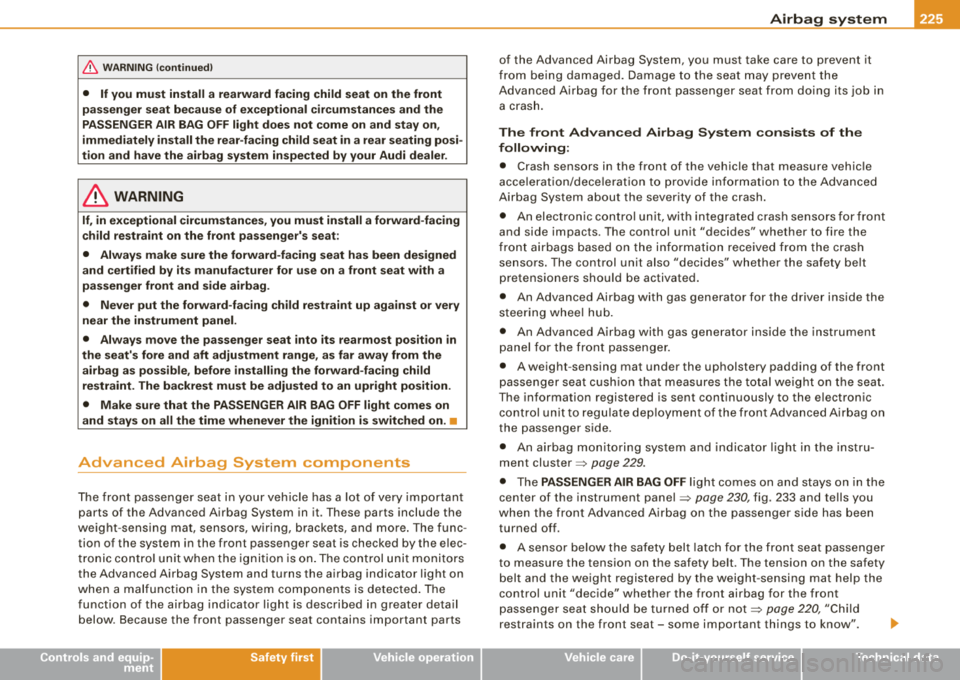
Airbag system -
--------------=---=--
& WARNING (continued)
• If you must install a rearward facing child seat on the front
passenger seat because of exceptional circumstances and the
PASSENGER AIR BAG OFF light does not come on and stay on,
immediately install the rear-facing child seat in a rear seating posi
tion and have the airbag system inspected by your Audi dealer.
& WARNING
If, in exceptional circumstances, you must install a forward-facing
child restraint on the front passenger's seat:
• Always make sure the forward-facing seat has been designed
and certified by its manufacturer for use on a front seat with a
passenger front and side airbag.
• Never put the forward-facing child restraint up against or very
near the instrument panel.
• Always move the passenger seat into its rearmost position in
the seat's fore and aft adjustment range, as far away from the
airbag as possible, before installing the forward-facing child
restraint. The backrest must be adjusted to an upright position.
• Make sure that the PASSENGER AIR BAG OFF light comes on
and stays on all the time whenever the ignition is switched on. •
Advanced Airbag System components
The front passenger seat in your vehicle has a lot of very important
parts of the Advanced Airbag System in it. These parts include the
weight -sensing mat, sensors, wiring, brackets, and more. The func
tion of the system in the front passenger seat is checked by the elec
tronic control unit when the ignition is on. The control unit monitors
the Advanced Airbag System and turns the airbag indicator light on
when a malfunction in the system components is detected. The
function of the airbag indicator light is described in greater detail below . Because the front passenger seat contains important parts
Controls and equip
ment Safety first Vehicle operation
of the Advanced Airbag System, you must
take care to prevent it
from being damaged. Damage to the seat may prevent the
Advanced Airbag for the front passenger seat from doing its job in
a crash.
The front Advanced Airbag System consists of the
following:
• Crash sensors in the front of the vehicle that measure vehicle
acceleration/deceleration to provide information to the Advanced
Airbag System about the severity of the crash.
• An electronic control unit, with integrated crash sensors for front
and side impacts. The control unit "decides" whether to fire the
front airbags based on the information received from the crash
sensors. The control unit also "decides" whether the safety belt
pretensioners should be activated.
• An Advanced Airbag with gas generator for the driver inside the
steering wheel hub.
• An Advanced Airbag with gas generator inside the instrument
panel for the front passenger.
• A weight -sensing mat under the upholstery padding of the front
passenger seat cushion that measures the total weight on the seat.
The information registered is sent continuously to the electronic
control unit to regulate deployment of the front Advanced Airbag on
the passenger side .
• An airbag monitoring system and indicator light in the instru
ment
cluster => page 229.
• The PASSENGER AIR BAG OFF light comes on and stays on in the
center of the instrument
panel => page 230, fig. 233 and tells you
when the front Advanced Airbag on the passenger side has been
turned off .
• A sensor below the safety belt latch for the front seat passenger
to measure the tension on the safety belt . The tension on the safety
belt and the weight registered by the weight-sensing mat help the
control unit
"decide" whether the front airbag for the front
passenger seat should be turned off or
not=> page 220, "Child
restraints on the front seat
-some important things to know". .,_
Vehicle care Do-it-yourself service Technical data
Page 231 of 404
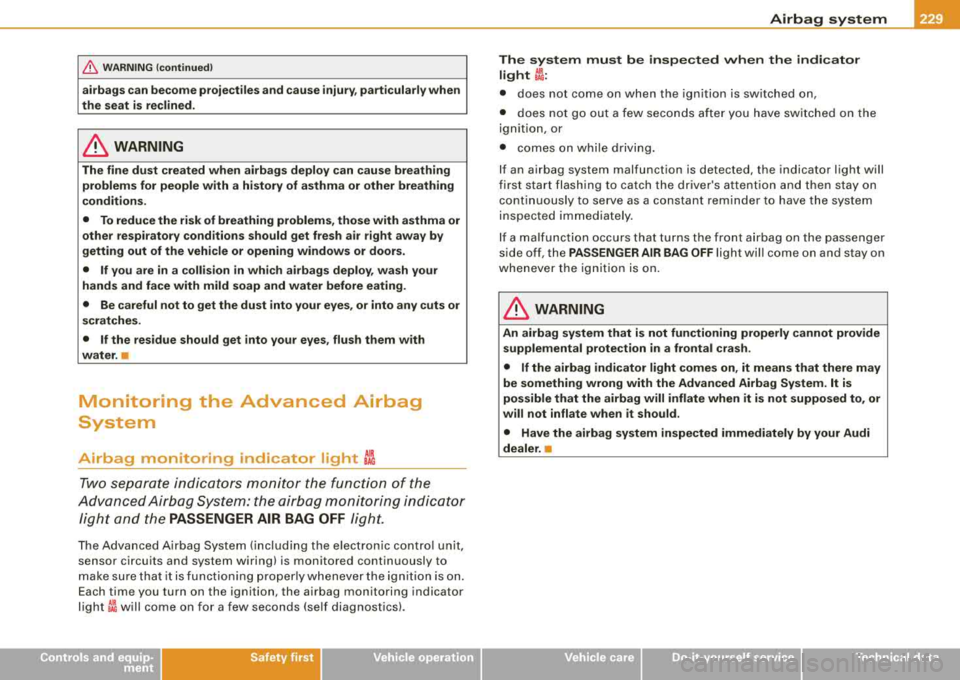
__________________________________________________ A_ i_ r _b _a-' g=- s_ y=- s_t _e _m __ fflll
& WARNING (continued )
airbags can become projectiles and cause injury , part icularly when
the seat is reclined .
& WARNING
The fine dust created when airbags deploy can cause breathing
problems for people with a history of asthma or other breathing
conditions.
• To reduce the risk of breathing problems, those with asthma or
other respiratory conditions should get fresh air right away by
getting out of the vehicle or opening windows or doors.
• If you are in a collision in which airbags deploy, wash your
hands and face with mild soap and water before eating.
• Be careful not to get the dust into your eyes , or into any cuts or
scratches .
• If the residue should get into your eyes , flush them with
water. •
Monitoring the Advanced Airbag
System
Airbag monitoring indicator light :~
Two s epa rate i ndic a tors mon itor the fu nction of the
Adv anc ed A irbag S ystem: the airbag monitor ing indi cator
light and the
PASSENGER AIR BAG OFF l igh t.
The Adva nce d A irbag S yst em ( includ ing t he e lec tronic co ntrol un it,
se nsor circuits and system wiring) is monitored continuously to
ma ke sure t hat it is fu nctio nin g properl y whene ver th e ig niti on i s on.
E ach time you t urn on the ignition, the airbag monitoring in dicator
lig ht ~ will co me on f or a few s econ ds (se lf diagnos tics).
Controls and equip ment Safety first
Vehicle operation
The system must be inspected when the indicator
light
:l t
• does not come on when the i gnition is switched on,
• do es no t go out a few se conds after you have sw itch ed o n the
ign it ion, or
• comes on while d riv in g.
I f an airbag syst em malfunction is d etected, the indicator light will
fi rs t sta rt fl ash ing to catch the d rive r's a tten tion an d th en s tay on
cont in uousl y to serve as a constant rem inder to have the system
i nspec ted i mm ed ia tely.
If a ma lfunction o ccurs that turns t he fro nt a irbag o n th e passe nger
side off, the PASSENGER AIR BAG OFF light will come on and stay on
w heneve r the ig nit io n is on.
& WARNING
An airbag system that is not functioning properly cannot provide
supplemental protection in a frontal crash .
• If the airbag indicator light comes on , it means that there may
be something wrong with the Advanced Airbag System . It is
possible that the airbag will inflate when it is not supposed to , or
will not inflate when it should .
• Have the airbag system inspected immediately by your Audi
dealer. •
Vehicle care Do-it-yourself service Technical data
Page 233 of 404
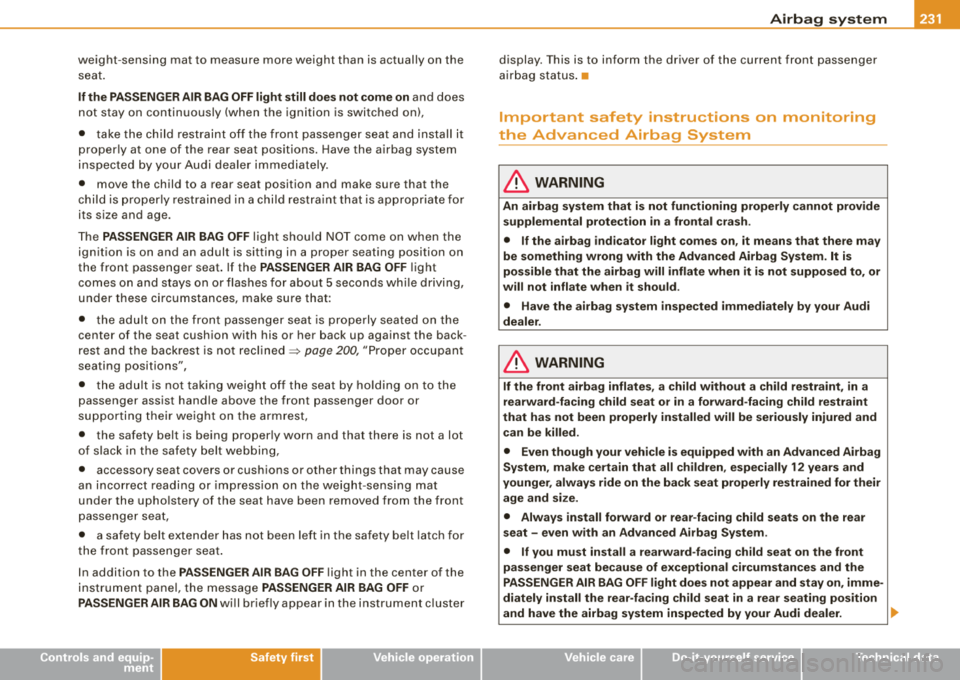
weight-sensing mat to measure more weight than is actually on the
seat .
If the PASSENGER AIR BAG OFF light still does not come on and does
not stay on continuously (when the ign ition is switched on) ,
• t ake the chil d re stra int off th e front passeng er seat and i nstall it
proper ly at one of the rear seat pos it ions . Have the a irbag system
i nspec ted by y our Audi d ealer im mediately.
• move the child to a rear seat position and make sure that the
c h ild is pro perl y restrai ned i n a c hild rest ra in t t ha t is ap prop ria te fo r
its s ize and age .
T he
PASSENGER AIR BAG OFF light s hou ld NOT come on when the
ignition is on and an adult is sittin g in a proper seating position on
the fro nt passenger seat . If the
PASSENGER AIR BAG OFF light
co me s on a nd stays o n or flas hes fo r abou t 5 s econds whi le d rivin g,
under these ci rcumstances , ma ke su re that :
• th e adult on the front passeng er sea t is pro pe rly s eate d on the
cent er of the seat cushion with his or her back up again st th e back
res t and the bac kres t is no t recl ined => page 20 0, "Pr oper o ccupa nt
seating positions",
• the adult i s not ta king w eight off the se at b y ho ld in g on to the
passenger assist handle above the front passenger door or
su ppo rtin g th eir we ig ht on t he ar mrest,
• the safety belt is being p roper ly worn and that there is not a lot
o f slac k in th e safety bel t webb ing,
• accessory seat covers or c ushions or other things that may cause
an incorrect r ead ing o r impre ss io n on th e w eight-s en sin g m at
unde r the upho lste ry of the seat have been removed from the front
p ass enger sea t,
• a safety belt extender has not been left in t he safety be lt latc h for
the fr ont pass enge r se at.
I n addition to the
PASSENGER AIR BAG OFF light in the center of th e
in stru men t p ane l, the message
PASSENGER AIR BAG OFF o r
PASSENGER AIR BAG ON wi ll briefly appe ar in the instrum ent c luster
Controls and equip
ment Safety first Vehicle operation
Airbag system
d
isplay . This is to inform the driver of the current front passenger
a irb ag stat us.•
Important safety instructions on monitoring
the Advanced Airbag System
& WARNING
An airbag system that is not functioning properly cannot provide
supplemental protection in a frontal crash.
• If the airbag indicator light comes on , it means that there may
be something wrong with the Advanced Airbag System . It is
possible that the airbag will inflate when it is not supposed to , or
will not inflate when it should.
• Have the airbag system inspected immediately by your Audi
dealer.
& WARNING
If the front airbag inflates , a child without a child restraint , in a
rearward-facing child seat or in a forward-facing child restraint
that has not been properly installed will be seriously injured and can be killed.
• Even though your vehicle is equipped with an Advanced Airbag
System , make certain that all children , especially 12 years and
younger, always ride on the back seat properly restrained for their
age and size .
• Always install forward or rear -facing child seats on the rear
seat -even with an Advanced Airbag System .
• If you must install a rearward-facing child seat on the front
passenger seat because of exceptional circumstances and the
PASSENGER AIR BAG OFF light does not appear and stay on , imme
diately install the rear-facing child seat in a rear seating position
and have the airbag system inspected by your Audi dealer .
~
Vehicle care Do-it-yourself service Technical data
Page 235 of 404
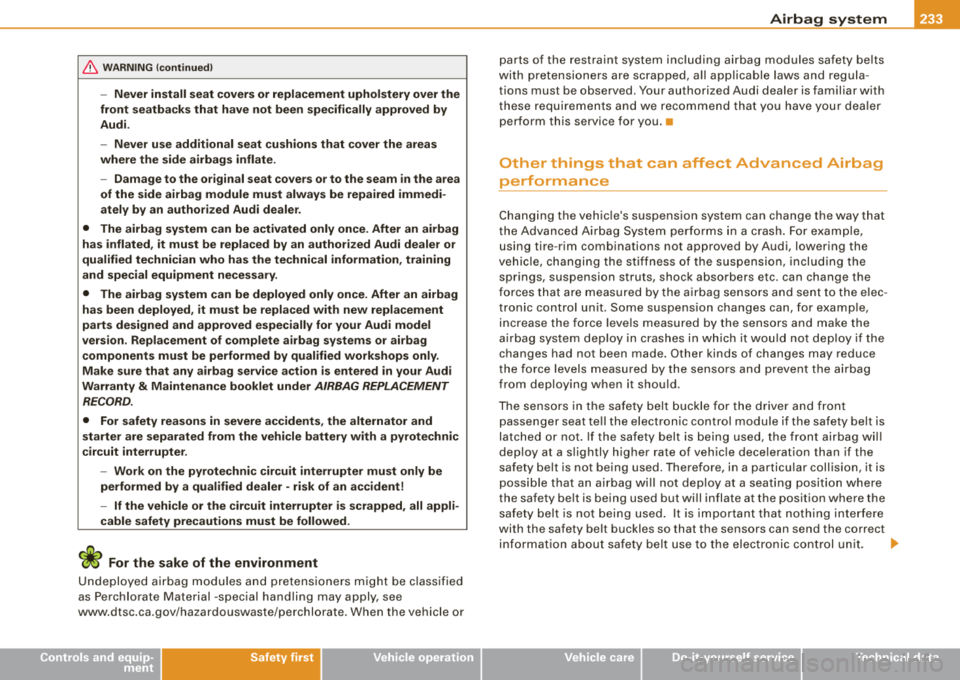
Airbag system -
--------------=---=--
& WARNING (continued )
-Never install seat covers or replacement upholstery over the
front seatbacks that have not been specifically approved by
Audi .
- Never use additional seat cushions that cover the areas
where the side airbags inflate.
- Damage to the original seat covers or to the seam in the area
of the side airbag module must always be repaired immedi
ately by an authorized Audi dealer .
• The airbag system can be activated only once. After an airbag
has inflated , it must be replaced by an authorized Audi dealer or
qualified technician who has the technical information , training
and special equipment necessary .
• The airbag system can be deployed only once . After an airbag
has been deployed , it must be replaced with new replacement
parts designed and approved especially for your Audi model
version . Replacement of complete airbag systems or airbag
components must be performed by qualified workshops only .
Make sure that any airbag service action is entered in your Audi
Warranty
& Maintenance booklet under AIRBAG REPLACEMENT
RECORD .
• For safety reasons in severe accidents , the alternator and
starter are separated from the vehicle battery with a pyrotechnic
circuit interrupter .
- Work on the pyrotechnic circuit interrupter must only be
performed by a qualified dealer
-risk of an accident!
- If the vehi cle or the circuit interrupter is scrapped, all appli
cable safety precautions must be followed .
For the sake of the environment
Undeployed ai rbag mod ule s and pr etensione rs mi ght b e cla ssi fied
as Perchlorate Material -sp ecial handling may ap ply, s ee
www .dtsc.ca.gov/hazardouswaste/perchlorate. When the vehicle or
Controls and equip
ment Safety first Vehicle operation
parts of th
e restraint syst em incl uding airbag modules saf ety be lts
w ith preten sio ne rs a re sc rapped, a ll a pp lic ab le laws a nd re g ul a
tions must be observ ed. Your authorized Audi deale r is fam iliar with
t hese req uir e m ents a nd we rec ommend tha t yo u have yo ur dea ler
perfor m this service for you .•
Other things that can affect Advanced Airbag
performance
C han ging the vehic le 's suspens ion system can change the way that
t h e Ad va n ce d Ai rbag Sys tem perfo rm s in a crash. F or e xam ple,
using ti re -r im comb inations not app rov ed by Audi, lower ing the
ve hic le , ch angi ng th e st iff ne ss of the su sp en sion , in cludin g the
springs, suspension struts, shock absorbers etc . can cha nge the
forc es that are measu re d b y th e a irbag sens ors a nd sen t to the e lec
t ronic con trol un it. Some suspens ion chan ges can, for exa mple,
i nc rea se the force le v e ls mea sured by the sen so rs and make the
a irb ag sys tem de plo y i n cras hes in whi ch it wo uld not de plo y if the
changes had not been made . Other kinds of changes may reduce
t h e force leve ls m easured by t he se nso rs a nd p reve nt t he a irba g
from deploy ing when it should .
T he se nsor s in th e safe ty bel t buc kle for th e dr ive r a nd fr ont
passen ger seat te ll th e electron ic control module if t he safety belt is
l a tc h e d or n ot. If t he safety belt is b ein g use d, th e fr ont ai rbag will
dep loy at a s lig htly h igher rate of veh ic le dece lerat ion t han if t he
safety belt is not being use d. Therefore, in a partic ular collision, it is
poss ible t hat an airba g w ill not deplo y at a s eat ing pos itio n where
the safety be lt is being used but wi ll inflate at the position where t he
sa fe ty be lt is no t bein g used. It i s im por ta nt th at n othi ng i nterfe re
with t he safety belt buc kles so that the sensors can send the correct
info rm ati on abou t sa fet y bel t use to th e ele ctr on ic co ntrol unit.
~
Vehicle care Do-it-yourself service Technical data
Page 237 of 404
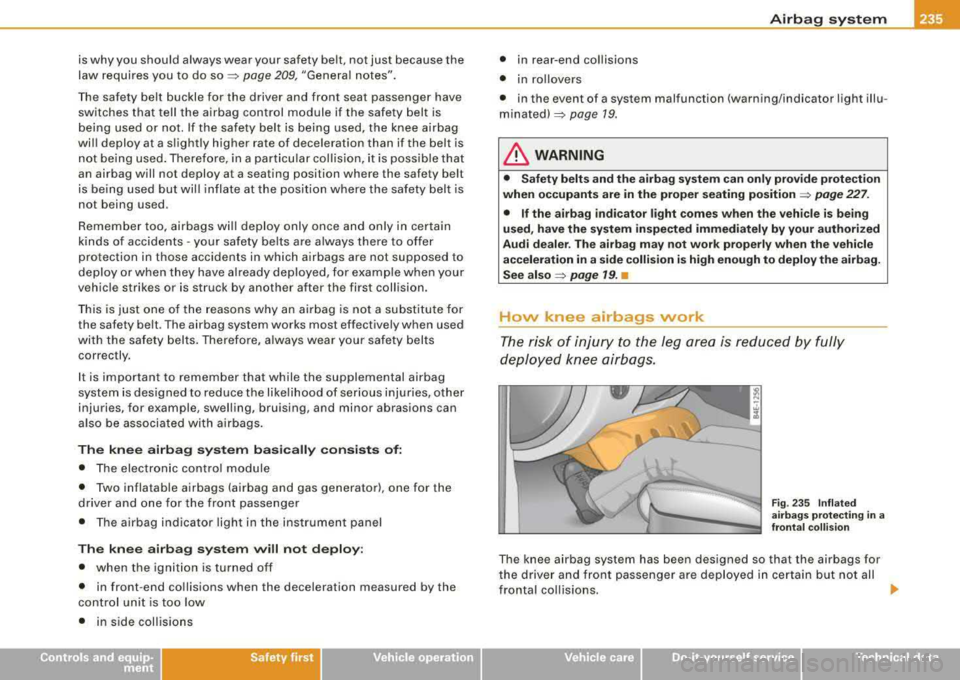
is why you should always wear your saf ety belt, not just because the
l a w requires you to do
so => page 209, "Genera l notes" .
The safety belt buckle for the driver and front seat passenger have switches that tell the airbag control module if the safety belt is
being used or not. If the sa fety bel t is being used, the knee airbag
will deploy at a s lightly higher rate of deceleration than if the belt is
not be ing used . Therefore, in a par ticular collision, it is possib le that
an airbag will not deploy at a seating position where the safety belt
is be ing used but will inflate at the position where the safety belt is
not being used .
Remember too, airbags will deploy only once and only in ce rtain
kinds o f accidents -your safety be lts are always there to o ffer
protection in those accidents in wh ich airbags are not supposed to
deploy or when they have already deployed, for examp le when you r
vehic le strikes or is struc k by another after the first collision.
T his is just one of the reasons why an ai rbag is not a subs titute for
the safety be lt. The airbag system works most effectively when used
with the safety belts. Therefore, a lways wear your safety belts
correctly.
I t is important to remember that while the supplemental airbag
system is designed to reduce the like lihood o f ser ious injuries, other
injuries, for example, swelling, bruising, and minor abrasions can
a lso be associated with airbags.
The kn ee airbag system bas ically consists of:
• T he electro nic control module
• T wo inflatable airbags (ai rbag and gas generato r), one for the
driver and one for the front passenger
• T he airbag indicator light in the instrument panel
The kn ee airbag system will not deploy :
• whe n the ignit ion is turned off
• in front -end collisions when the deceleration measured by the
control uni t is too low
• in side collisions
Airb ag syst em
• in rear -end co llisions
• in ro llovers
• in the event of a system malfunction (warning/indicator light illu
minated)=> page 19 .
& WARNING
• Safety belts and the airbag sy stem ca n only provide protec tion
when oc cupants are in the proper seating po sition
=> page 227 .
• If the airbag indi cator light comes when the vehi cle is b eing
u sed , have the system in spected immediately by your authorized
Audi dealer . The airbag may not work properl y when the vehicle
acceleration in a side colli sion is high enough to deploy the a irbag.
See
also => page 19. •
How knee airbags work
The risk of injury to the leg are a is reduce d by fully
depl oye d knee air ba gs.
-
Fig . 235 I nfl ate d
airba gs prot ecting in a
frontal colli sio n
The knee airbag system has been designed so that the airbags for
t he drive r and front passenger a re deployed in certain but not all
frontal col lisions.
ill-
Vehicle care I I Technical data
Page 239 of 404
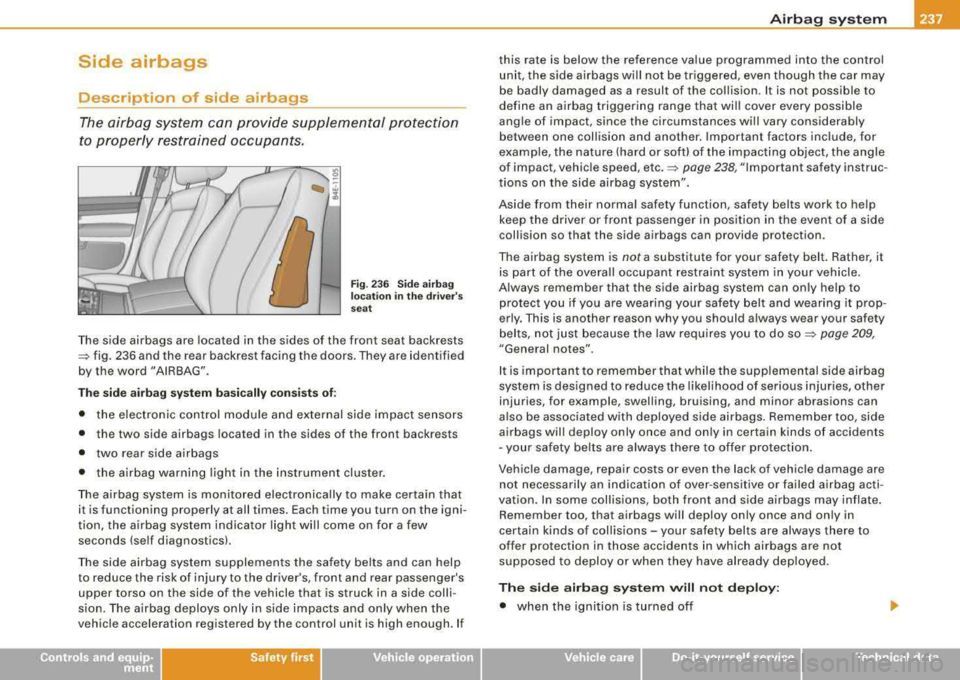
Side airbags
Description of side airbags
The airbag system can provide supplemental protecti on
to properly restrained occupants.
Fi g. 23 6 Sid e a ir b ag
lo ca tio n in the d riv er' s
sea t
The side airbags are located in the sides of the front seat backrests
=> fig. 236 and the rear backrest facing the doors . They are identified
by the word "AIRBAG" .
The side airbag system b asic ally con sist s of :
• the electronic control module and external side impact sensors
• the two side airbags located in the sides of the front backrests
• two rear side airbags
• the a irbag warning light in the instrument cluster.
The airbag system is monitored electronically to make certain that it is functioning properly at all times. Each time you turn on the igni
tion, the airbag system indicator light wi ll come o n for a few
seconds (self diagnostics).
The side airbag system supplements the safety belts and can help to reduce the risk of injury to the driver's, front and rear passenger's
upper torso on the side of the vehicle that is struck in a side colli
s ion. The airbag deploys only in s ide impacts and on ly when the
vehicle acceleration registered by the control unit is high enough . If
Airb ag syst em
this rate is below the reference value programmed into the control
un it, the side airbags w ill not be triggered, even though the car may
be badly damaged as a result of the col lision. It is not possible to
define an airbag triggering range that wi ll cover every possible
ang le of impact, since the circumstances will vary considerably
between one collision and another. Important factors include, for
examp le, the nature (hard or soft) of the impacting object, the angle
of impact, vehic le speed, etc. =>
page 238, "Important safety instruc
tions on the side airbag system".
Aside from their norma l safety function, safety belts work to he lp
keep the driver or front passenger in position in the event of a side
collision so that the side airbags can provide protection .
The airbag system is
not a substitute for your safety belt . Rathe r, it
is part of the overa ll occupant restraint system in your vehicle.
Always remember that the side airbag system can only he lp to
pro tect you if you are wearing your safety belt and wear ing it prop
erly. This is another reason why you should a lways wear your safety
b elts, n ot just because the law requires you to do so =>
page 209,
"General notes".
I t is important to remember tha t while the supplementa l side airbag
system is designed to reduce the likelihood of serious injuries, other
injuries, for example, swelling, bruising, and minor abrasions can
a lso be associated with deployed side airbags . Remember too, side
airbags will deploy only once and on ly in certain kinds of accidents
-your safety belts are always there to offer pro tec tion .
Vehicle damage, repair costs or even the lack of vehicle damage are not necessarily an indication of over -sensi tive or failed airbag acti
vation . In some collisions, both front and side airbags may inflate.
Remember too , that airbags will deploy on ly once and only in
certain kinds of collisions -your safety belts are always there to
offer protection in those acc idents in which airbags are not
supposed to deploy or when they have already dep loyed.
The sid e airbag system will not deploy :
• when the ignition is turned of f
Vehicle care I I Technical data
Page 241 of 404
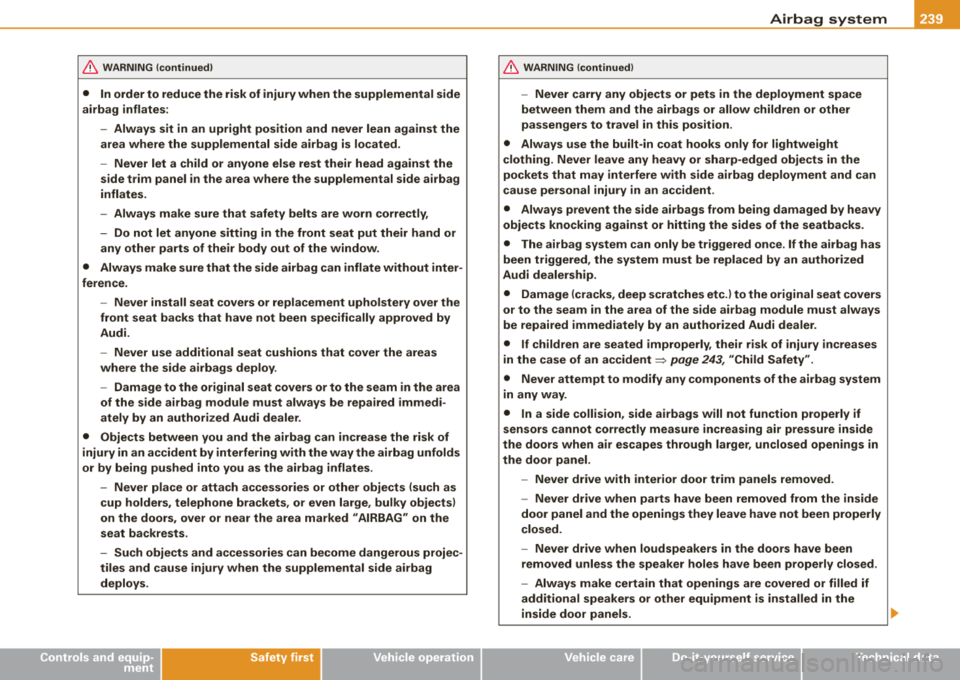
---------------------------------------------~A~ ir'..!b!: a:! g~ s~ yr_; s::!. t~ e~ m~ _lffllll
& WARNING (continued)
• In order to reduce the risk of injury when the supplemental side
airbag inflates:
-Always sit in an upright position and never lean against the
area where the supplemental side airbag is located.
- Never let a child or anyone else rest their head against the
side trim panel in the area where the supplemental side airbag
inflates.
- Always make sure that safety belts are worn correctly,
- Do not let anyone sitting in the front seat put their hand or any other parts of their body out of the window.
• Always make sure that the side airbag can inflate without inter
ference.
-Never install seat covers or replacement upholstery over the
front seat backs that have not been specifically approved by
Audi.
- Never use additional seat cushions that cover the areas
where the side airbags deploy .
- Damage to the original seat covers or to the seam in the area
of the side airbag module must always be repaired immedi
ately by an authorized Audi dealer .
• Objects between you and the airbag can increase the risk of
injury in an accident by interfering with the way the airbag unfolds
or by being pushed into you as the airbag inflates .
- Never place or attach accessories or other objects (such as cup holders, telephone brackets, or even large, bulky objects}
on the doors, over or near the area marked "AIRBAG" on the
seat backrests .
- Such objects and accessories can become dangerous projec
tiles and cause injury when the supplemental side airbag
deploys.
Controls and equip ment Safety first
Vehicle operation
& WARNING (continued)
-Never carry any objects or pets in the deployment space
between them and the airbags or allow children or other
passengers to travel in this position .
• Always use the built -in coat hooks only for lightweight
clothing. Never leave any heavy or sharp-edged objects in the
pockets that may interfere with side airbag deployment and can
cause personal injury in an accident.
• Always prevent the side airbags from being damaged by heavy
objects knocking against or hitting the sides of the seatbacks.
• The airbag system can only be triggered once. If the airbag has
been triggered, the system must be replaced by an authorized
Audi dealership.
• Damage (cracks, deep scratches etc.} to the original seat covers
or to the seam in the area of the side airbag module must always
be repaired immediately by an authorized Audi dealer.
• If children are seated improperly, their risk of injury increases
in the case of an
accident => page 243, "Child Safety".
• Never attempt to modify any components of the airbag system
in any way.
• In a side collision , side airbags will not function properly if
sensors cannot correctly measure increasing air pressure inside
the doors when air escapes through larger, unclosed openings in
the door panel.
-Never drive with interior door trim panels removed.
- Never drive when parts have been removed from the inside
door panel and the openings they leave have not been properly
closed.
- Never drive when loudspeakers in the doors have been
removed unless the speaker holes have been properly closed .
- Always make certain that openings are covered or filled if
additional speakers or other equipment is installed in the
inside door panels .
Vehicle care Do-it-yourself service Technical data
Page 245 of 404
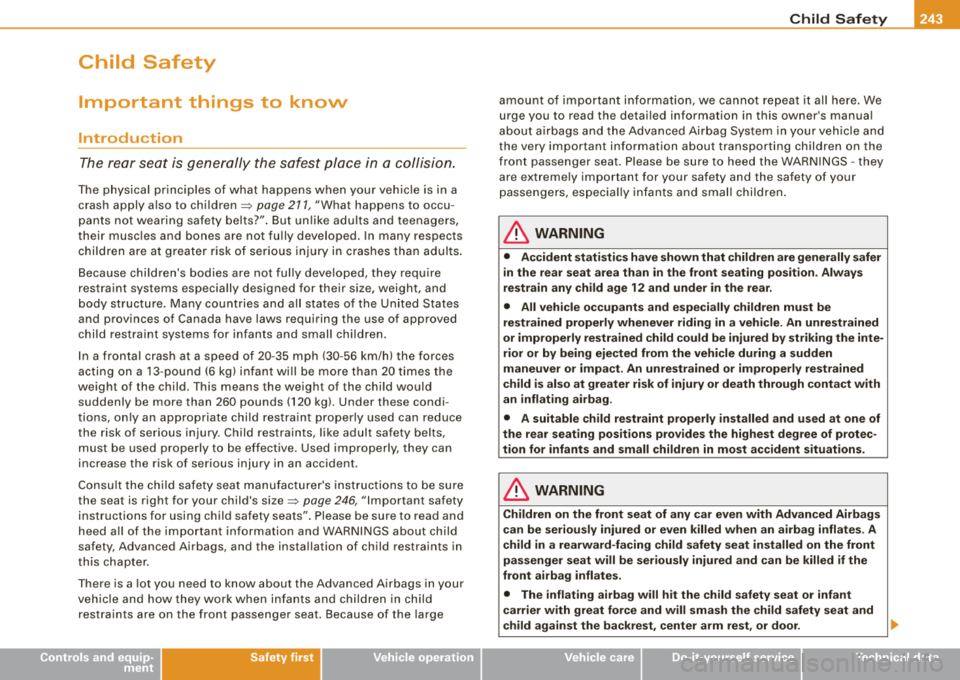
_______________________________________________ C_h _ i_ld _ S_ a_ f_ e_ t..a y __ ffllll
Child Safety
Important things to know
Introduction
The rear seat is generally the safest place in a collision.
The physical principles of what happens when your vehicle is in a
crash apply also to children
=> page 211, "What happens to occu
pants not wearing safety belts?". But unlike adults and teenagers,
their muscles and bones are not fully developed. In many respects
children are at greater risk of serious injury in crashes than adults.
Because children's bodies are not fully developed, they require
restraint systems especially designed for their size, weight, and
body structure. Many countries and all states of the United States
and provinces of Canada have laws requiring the use of approved
child restraint systems for infants and small children.
In a frontal crash at a speed of 20-35 mph (30-56 km/h) the forces
acting on a 13-pound (6 kg) infant will be more than 20 times the
weight of the child. This means the weight of the child would
suddenly be more than 260 pounds (120 kg). Under these condi
tions , only an appropriate child restraint properly used can reduce
the risk of serious injury. Child restraints, like adult safety belts,
must be used properly to be effective. Used improperly, they can
increase the risk of serious injury in an accident.
Consult the child safety seat manufacturer's instructions to be sure
the seat is right for your child's
size=> page 246, " Important safety
instructions for using child safety seats". Please be sure to read and
heed all of the important information and WARNINGS about child
safety, Advanced Airbags, and the installation of child restraints in
this chapter.
There is a lot you need to know about the Advanced Airbags in your
vehicle and how they work when infants and children in child
restraints are on the front passenger seat. Because of the large
Controls and equip
ment Safety first Vehicle operation
amount of
important information, we cannot repeat it all here. We
urg e you to read the detailed information in this owner's manual
about airbags and the Advanced Airbag System in your vehicle and
the very important information about transporting children on the
front passenger seat. Please be sure to heed the WARNINGS -they
are extreme ly important for your safety and the safety of your
passengers, especially infants and small children.
& WARNING
• Accident statistics have shown that children are generally safer
in the rear seat area than in the front seating position. Always
restrain any child age 12 and under in the rear.
• All vehicle occupants and especially children must be
restrained properly whenever riding in a vehicle. An unrestrained
or improperly restrained child could be injured by striking the inte
rior or by being ejected from the vehicle during a sudden
maneuver or impact . An unrestrained or improperly restrained
child is also at greater risk of injury or death through contact with
an inflating airbag.
• A suitable child restraint properly installed and used at one of
the rear seating positions provides the highest degree of protec
tion for infants and small children in most accident situations.
& WARNING
Children on the front seat of any car even with Advanced Airbags
can be seriously injured or even killed when an airbag inflates . A
child in a rearward-facing child safety seat installed on the front
passenger seat will be seriously injured and can be killed if the
front airbag inflates.
• The inflating airbag will hit the child safety seat or infant
carrier with great force and will smash the child safety seat and
child against the backrest, center arm rest, or door. ..,_
Vehicle care Do-it-yourself service Technical data
Page 247 of 404
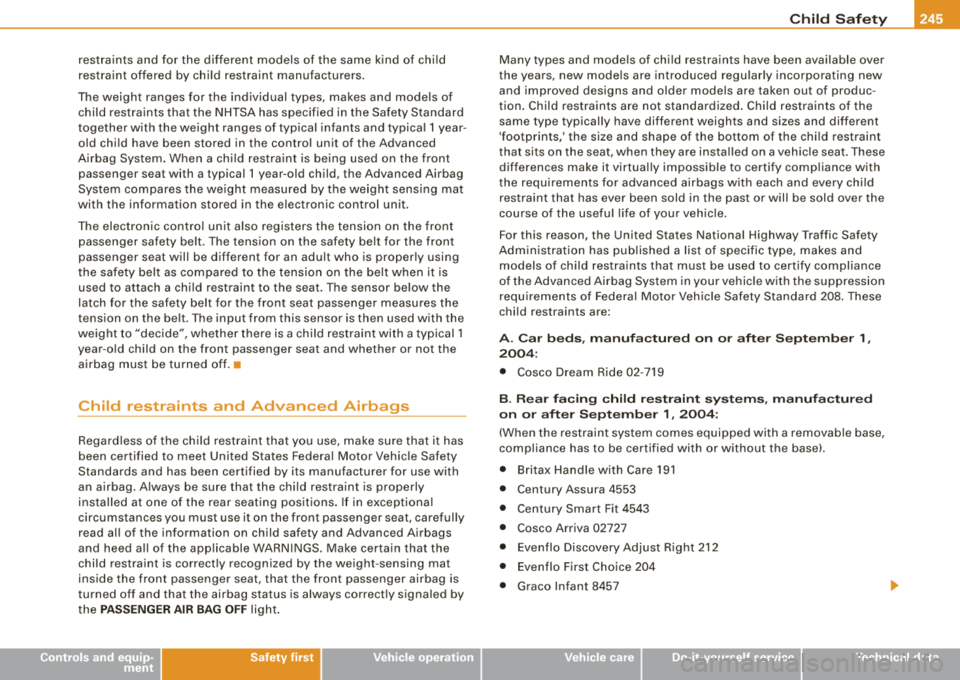
-----------------------------------------~C:_! h~ i~ l d~ S~a !!f ~e _!:t YL _ffllll
restraints and for the different models of the same kind of child
restraint offered by child restraint manufacturers .
The weight ranges for the individual types , makes and mode ls of
child restraints that the NHTSA has specified in the Safety Standard
together with the weight ranges of typ ical infants and typica l 1 year
old child have been stored in the control unit of the Advanced
Airbag System. When a ch ild restra int is being used on the front
passenger sea t wi th a typical 1 y ear-old child, the Advanced Airbag
System compares the weight measured by the weight sensing mat
with the information stored in the e lectronic control unit .
The electronic contro l unit also registers the tension on the front
passenger safety be lt . The tens ion on the safety belt for the front
passenger seat will be different for an adult who is properly using
the safety belt as compared to the tension on the belt when it is used to attach a chi ld restraint to the seat. The sensor below the
latch for the safety belt for the front seat passenger measures the
t e nsion on th e be lt . The input from this sensor is then used with the
weight to "decide" , w hether there is a child restraint with a typical 1
year-o ld child on the front passenger seat and whether or not the
airbag must be turned off .•
Child restraints and Advanced Airbags
Regard less of the child restraint that you use, make sure that i t has
been certified to meet United States Federa l Motor Vehic le Safety
Standards and has been certified by its manufacturer for use with
an airbag . Always be sure that the chi ld restraint is properly
insta lled at one of the rear seating positions . If in exceptiona l
circumstances you must use it on the front passenger seat, carefully
read all of the information on child safety and Advanced Airbags
and heed a ll of the app licable WARNINGS. Make certain that the
child restraint is correct ly recognized by the weight -sensing mat
inside the front passenger seat, that the front passenger airbag is
turned off and that the airbag status is always correct ly signa led by
t he
P ASS ENGER AIR B AG OFF light .
Controls and equip
ment Safety first Vehicle operation
Many types and mode
ls of chi ld restraints have been available over
t he years, new mode ls are introduced regular ly incorpora ting new
and improved designs and older models are taken out of produc
tion. Child rest raints are not standardized . Child restraints of the
same type typically have different weights and sizes and different
'footprints,' the size and shape of the bottom of the chi ld restra int
that sits on the seat, when they are insta lled on a veh ic le seat. These
differences make it virtua lly impossible to certify comp liance with
the requirements for advanced airbags with each and every child restraint that has ever b een sold in th e past or will b e sold over the
course of the usefu l life of your veh ic le .
For this reason, the Uni ted S tates National Highway Traffic Safety
Admin istration has pub lished a lis t of spec ific type, makes and
models of child restra ints that must be used to cert ify compl iance
of the Advanced Airbag System in your vehicle with the suppression
requ irements of Federa l Motor Veh ic le Safety Standard 208. These
child restraints are:
A. Ca r beds, man ufac tured on or afte r Sept ember 1 ,
20 0 4:
• Cosco Dream R ide 02-719
B . Rea r fa cin g c hild re straint syste ms, manu factured
o n or aft er Se ptemb er 1 , 20 04:
(When the restraint system comes equipped with a removab le base,
compliance has to be certified with or without the base) .
• Britax Handle with Care 191
• Century Assura 4553
• Century Smart F it 4543
• Cosco Arriva 02727
• E venflo Discovery Adjust R ig ht 212
• Evenflo First Choice 204
• Graco lnfant8457
Vehicle care Do-it-yourself service Technical data
Page 249 of 404
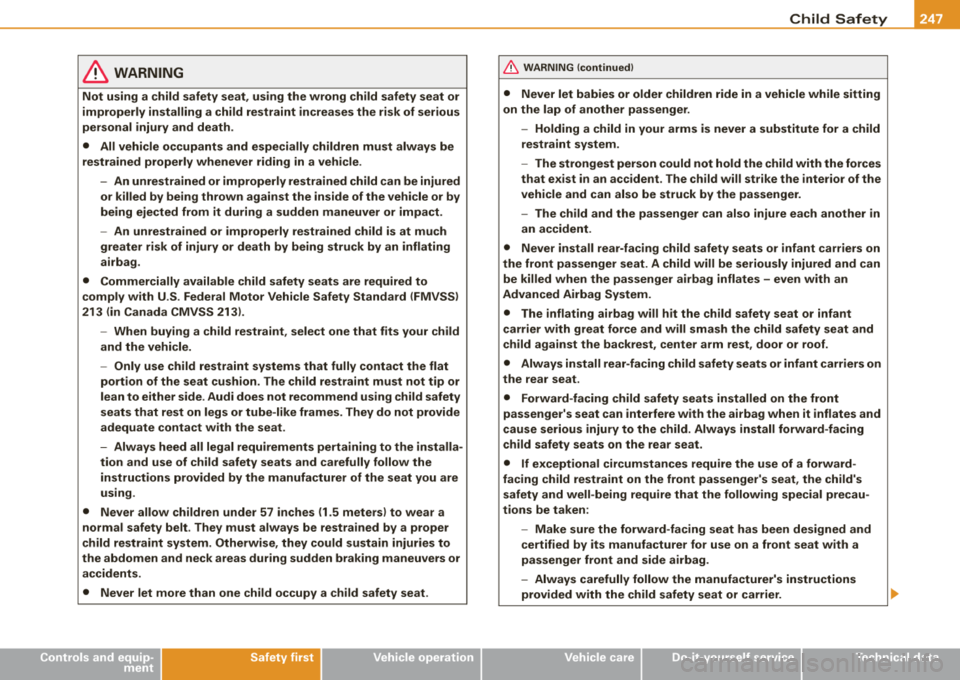
_____________________________________________ C_ h
_ il_d _S_ a
_ fe_t--' y'---_ffllll
& WARNING
Not using a child safety seat , using the wrong child safety seat or
improperly installing a child restraint increases the risk of serious
personal injury and death .
• All vehicle occupants and especially children must always be
restrained properly whenever riding in a vehicle .
- An unrestrained or improperly restrained child can be injured or killed by being thrown against the inside of the vehicle or by
being ejected from it during a sudden maneuver or impact.
- An unrestrained or improperly restrained child is at much
greater risk of injury or death by being struck by an inflating
airbag.
• Commercially available child safety seats are required to
comply with U .S . Federal Motor Vehicle Safety Standard (FMVSS l
213 (in Canada CMVSS 2131.
-When buying a child restraint , select one that fits your child
and the vehicle .
- Only use child restraint systems that fully contact the flat
portion of the seat cushion. The child restraint must not tip or
lean to either side . Audi does not recommend using child safety
seats that rest on legs or tube -like frames. They do not provide
adequate contact with the seat .
- Always heed all legal requirements pertaining to the installa
tion and use of child safety seats and carefully follow the
instructions provided by the manufacturer of the seat you are
using.
• Never allow children under 57 inches (1 .5 meters) to wear a
normal safety belt. They must always be restrained by a proper
child restraint system. Otherwise, they could sustain injuries to
the abdomen and neck areas during sudden braking maneuvers or
accidents.
• Never let more than one child occupy a child safety seat .
Controls and equip ment Safety first
Vehicle operation
&, WARNING (continued)
• Never let babies or older children ride in a vehicle while sitting
on the lap of another passenger .
- Holding a child in your arms is never a substitute for a child
restraint system .
- The strongest person could not hold the child with the forces
that exist in an accident. The child will strike the interior of the
vehicle and can also be struck by the passenger .
- The child and the passenger can also injure each another in
an accident.
• Never install rear-facing child safety seats or infant carriers on
the front passenger seat . A child will be seriously injured and can
be killed when the passenger airbag inflates - even with an
Advanced Airbag System .
• The inflating airbag will hit the child safety seat or infant
carrier with great force and will smash the child safety seat and
child against the backrest , center arm rest , door or roof .
• Always install rear-facing child safety seats or infant carriers on
the rear seat .
• Forward-facing child safety seats installed on the front
passenger's seat can interfere with the airbag when it inflates and
cause serious injury to the child. Always install forward -facing
child safety seats on the rear seat .
• If exceptional circumstances require the use of a forward
facing child restraint on the front passenger's seat , the child's
safety and well -being require that the following special precau
tions be taken:
- Make sure the forward -facing seat has been designed and
certified by its manufacturer for use on a front seat with a
passenger front and side airbag.
- Always carefully follow the manufacturer's instructions
provided with the child safety seat or carrier.
Vehicle care Do-it-yourself service Technical data